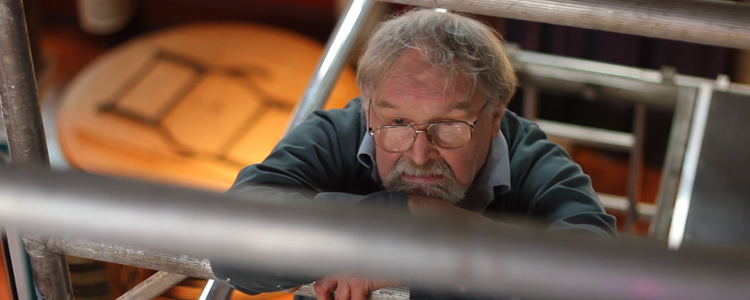
In November 2019, the Saltire Literary Awards presented its inaugural Lifetime Achievement Award to Alasdair Gray, a true icon of Scottish art – and a true iconoclast. Gray was an artist in every form: a writer of poetry, plays, criticism, historical and political philosophy; a painter; an illustrator and designer; a teacher; a translator. In his own words he was a ‘maker of imagined objects’.
Gray’s work is at once instantly familiar and always unexpected. He combined and juxtaposed written word and visual image to form epic narratives, pushing boundaries of form and shape. But if the hallmark of his work is its formal experimentation, its heart is Glasgow. Gray was born in Riddrie in 1934, trained as a mural painter at Glasgow School of Art, and lived and worked in the West End of the city. His formative experience in the city would inform his lifelong determination to challenge social structures that do not recognise the humanity of their people.
“If a city hasn’t been used by an artist not even the inhabitants live there imaginatively ... Imaginatively Glasgow exists as a music-hall song and a few bad novels. That’s all we’ve given to the world outside. It’s all we’ve given to ourselves.”
From Lanark by Alasdair Gray
Gray’s own favourite among his works was his second novel 1982, Janine, published in 1984, but he is perhaps best known for his debut novel Lanark. A form-defying dual narrative melding realist depictions of Glasgow with dystopian surrealism, the novel is a love-letter to the city, a classic of postmodern fiction and perhaps the single most influential work of Scottish literature of the modern era.
It won Book of the Year at the Saltire Literary Awards and Scottish Arts Council Book Awards and immediately established Gray as a major literary figure. He would go on to win both the Guardian and Whitbread book awards and publish a further nine novels.
While there is a distinct darkness running through Gray’s work, there is always humanity and hope. His artistic mantra was: ‘Work as if you live in the early days of a better nation’. He lived by it so completely that many assume it to have been his own creation; in fact, it is from the work of poet Dennis Lee.
This borrowing was emblematic of a career in which much of Gray’s work was created in response to other artists – he even included a tongue-in-cheek ‘List of Plagiarisms’ in Lanark. In turn, he would engender the confidence that ushered in Scotland’s modern literary renaissance. His influence carries through into the work of writers as diverse as Iain Banks and Irvine Welsh, Ali Smith, A. L. Kennedy, Ian Rankin, Janice Galloway, and David Greig.
Alasdair Gray was unable to pick up the Saltire Award due to ill-health; we were deeply saddened to hear of his death in late December. Our thoughts are with his family and friends. We have no doubt that his legacy will live on through his own amazing body of work and through the next generation of Scottish writers and artists.
Lanark is a great place to start to explore Gray’s writing. Poor Things is a brilliant retelling of Frankenstein.
Find some of Gray’s most iconic visual art in the West End of Glasgow, where there are murals in Hillhead Underground Station, Òran Mòr and the Ubiquitous Chip restaurant.
Ali Smith’s Artful owes something to Gray. Short-story collection Elsewhere: There introduces an exciting range of confident Scottish voices. Jenni Fagan is one of our most vital; try her debut The Panopticon.